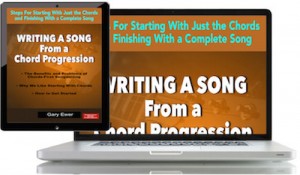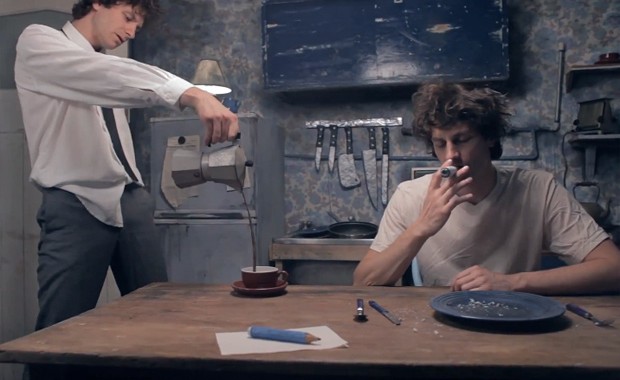We know that creating contrast is an important principle in the structure of good songwriting. Contrast is naturally sought by listeners, and they’re not usually aware that they’re seeking it.
When melodies are low, we assume they’ll move higher. When music is soft, we expect that something louder is going to happen.
If you listen to”Firework” (Katy Perry, et al), there’s an almost octave-and-a-half difference between the main notes of the verse and the chorus. But in most songs, contrast is actually a much more subtle quality. You’ll notice, for example, in Lennon’s “Imagine”, the verse and chorus melodies are almost in the same range. The chorus is only slightly higher than the verse, but that slight difference is all that seems to be necessary.
That fact, that the chorus of “Imagine” is only slightly higher than the verse, may be touching on a similar concept in the field of psychology known as perceptual contrast.
Perceptual contrast refers to the impression you get that two things, when you compare them, seem more different than they really are. If you lift two objects, you might notice that the second object is lighter than the first one, but you’ll also probably over-estimate how much lighter it is.
 Do you like starting songs with the chords first? If so, you’ll find Gary’s most recent eBook, “Writing a Song From a Chord Progression“, to be very helpful. It describes the pros and cons from chords-first songwriting, and gives you a way to make that method work for you. It’s part of “The Essential Secrets of Songwriting” 10-eBook Deluxe Bundle. READ MORE..
Do you like starting songs with the chords first? If so, you’ll find Gary’s most recent eBook, “Writing a Song From a Chord Progression“, to be very helpful. It describes the pros and cons from chords-first songwriting, and gives you a way to make that method work for you. It’s part of “The Essential Secrets of Songwriting” 10-eBook Deluxe Bundle. READ MORE..
Marketers have used perceptual contrast when trying to convince potential buyers. They’ll show the customer one or two items of less quality, probably overpriced, and then show them the item they really want to sell them. By contrast, the desirable item seems like an extraordinary deal, far better than if they had simply started with the better item.
So it seems that we have this natural tendency to compare. But as we see, it’s more than that. It would seem that when we perceive contrasting elements in music, we’re not very good at determining how different they are. It’s all subjective, and that’s not a bad thing.
Why is this important to songwriters? It gets to the issue of subtlety, in this way:
- Melodic Range. Chorus melodies are usually higher than verse melodies, but they don’t need to be greatly higher. Sometimes, moving a chorus up so that it’s only a note or two higher than the verse is all that’s necessary.
- Instrumental Volume. Choruses are often louder than verses, and we like to hear that contrast. But don’t assume that that difference needs to be dramatic. Sometimes, adding an instrument or two into the mix is all that’s needed.
- Lyrical Emotion. While it’s true that verses tell stories and choruses emote about them, the difference may only need to be a subtle one. If your song is about how much you miss someone, it’s not reasonable to assume that your verse will simply give an unemotional rendition of events. Emotions will be everywhere. Just be sure that the chorus opens up a bit, and in lieu of telling more of the story, allows the singer to express a clear emotional reaction. Don’t worry so much if the verse and chorus, in emotional songs, are relatively similar.
- Major and Minor. Verses will often focus on minor chords, and then switch to mainly major for the chorus. That’s a nice technique to try. But it’s quite likely that all you need is a verse progression that starts on a minor chord, even if the rest of the progression is mainly major. So here’s a verse-chorus chord partnership that’s subtly different, but all you probably need: VERSE: Am F C G… ||CHORUS: C F C G
- Melodic Rhythm. This is perhaps the most subtle difference, one governed by the words you use. Verse rhythms tend to be fairly active, using lots of syncopation and other rhythmic devices. But the chorus rhythms, particularly the ones that include the song title, will elongate and simplify. It’s rarely something audiences will find obvious, but they’ll perceive the difference on a subconscious level. Compare the rhythms of the verse and chorus melodies in “Penny Lane” (Lennon & McCartney) or “Easy Way Out” (Wally De Backer (Gotye)), and you’ll notice this right away.
Contrast, while being crucial to strong song structure, only needs subtlety to do its work. By overworking the concept of contrast in your music, you might be inadvertently interfering with the smooth flow of your music from beginning to end.
Remember that once someone experiences the contrast, they’re likely to assume it’s been more of a difference than it really is. And that can be good.
 Written by Gary Ewer. Follow Gary on Twitter
Written by Gary Ewer. Follow Gary on Twitter
 “Fix Your Songwriting Problems – NOW” takes a look at some of the most common errors made by songwriters. Think of it as a quick-start guide to getting you on the fast track to writing better songs. It’s part of “The Essential Secrets of Songwriting” 10-eBook Deluxe Bundle. Read More..
“Fix Your Songwriting Problems – NOW” takes a look at some of the most common errors made by songwriters. Think of it as a quick-start guide to getting you on the fast track to writing better songs. It’s part of “The Essential Secrets of Songwriting” 10-eBook Deluxe Bundle. Read More..











This is an in depth vision of the importance of Contrast,in songwriting
and something all songwriters can learn from, as always it stresses
the importance of studying the past and present hits of popular songs